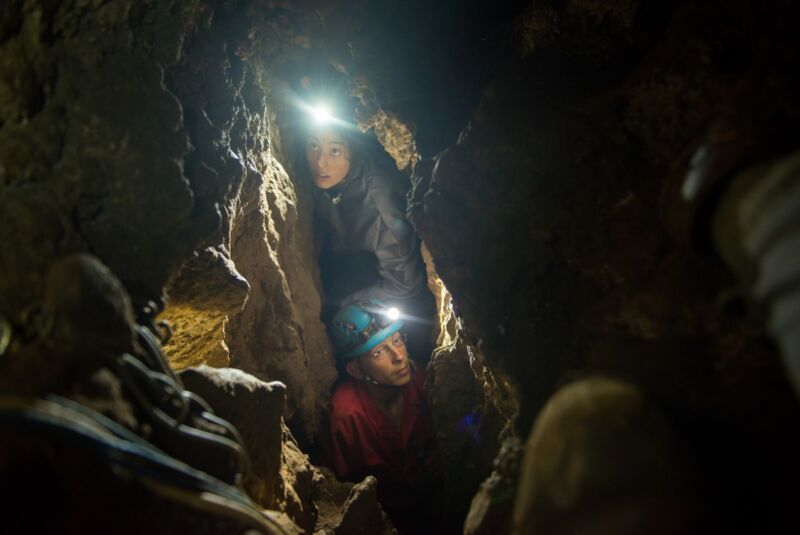
[ad_1]

Robert Clark/National Geographic
Some 25 miles outside of Johannesburg, South Africa, there is a famous paleoanthropological site known as the Cradle of Humankind. So many hominin bones were found in the region that it was designated a UNESCO World Heritage site in 1999. Among the many limestone caves in the region is the Rising Star cave, where cavers discovered fossils representing a new hominin species, Homo naledi, in 2015. Only H. naledi remains were found in the cave, suggesting the possibility that the bodies had been placed there deliberately, although this hypothesis proved to be a bit controversial.
Now the same expedition team has announced the discovery of H. naledi bodies deposited in fetal positions, indicating intentional burials. This predates the earliest known burials by Homo sapiens by at least 100,000 years, suggesting that brain size might not be the definitive factor behind such complex behavior. The team also found crosshatched symbols engraved on the walls of the cave that could date as far back as 241,000–335,000 years, although testing is still ongoing.
Taken together, the discoveries provide evidence of a major cognitive step in human evolution in terms of mortuary practices and meaning-making. The team described these new findings during a virtual press conference and in three new preprints posted to the BioRxiv, which will be published later this year in the journal eLife.
“I think we are facing a remarkable discovery here of hominids with brains a third the size of living humans, and slightly larger than chimpanzees, burying their dead—something previously only found in large-brained hominids—as well as etching meaning-making symbols on the wall,” said Lee Berger, a paleoanthropologist and National Geographic Explorer in Residence who leads the Rising Star Project. “This would mean not only are humans not unique in the development of symbolic practices, but [they] may not even have invented such behaviors.”
Naturally, there are skeptics. For instance, María Martinón-Torres, director of Spain’s National Research Center on Human Evolution, told the New York Times that such speculations were premature based on the evidence presented so far, suggesting that funerary caching was a more likely scenario than burials. “Hypotheses need to be built on what we have, not what we guess,” she said. “Still, I think the possibility of having funerary caching with this antiquity is already stunning.”
3D virtual tour beginning in the Hill Antechamber at the base of the ladder where explorers enter, through the passage linking to the Dinaledi Chamber where two burial features were found. Credit: Corey Jaskolski/National Geographic.
The story of Homo naledi technically begins millions of years ago, when the cradle’s network of limestone caves first formed. As Lydia Pyne wrote for Ars in 2018:
Caves in that area of South Africa form as water percolates through the cracks and fissures of the region’s dolomite rock and slowly erodes the rock away, forming underground caverns of all shapes and sizes. As water flows through these caves, it leaves behind deposits of calcium carbonates—easily recognizable as concrete-hard breccias or sheet-like deposits of flowstone found along cave walls. In the Rising Star cave system, this resulted in a network of chambers, including those where researchers have recovered Homo naledi fossils.
Recreational cavers had been exploring parts of the Rising Star system since the 1960s. But Berger hired a team of cavers in 2013 to survey the cave more thoroughly to map out any chambers with potentially significant fossils. That team included Rick Hunter and Steven Tucker, who used a 1985 map to guide their explorations. The duo managed to worm their way through a previously unmapped slot just 18 centimeters (7 inches) wide and found themselves in one of the cave chambers. There, they saw a treasure trove of fossilized bones. “When we first saw the mandible, we thought, ‘Maybe this was the last guy that came down to the chamber and didn’t make it out,'” Hunter told Ars in 2018.
The reality was potentially much more significant. Excited by the discovery, Berger hired an additional team of six women with both scientific and caving experience to excavate the site (using toothpicks and sometimes porcupine quills, among other tools). The entire three-week excavation played out live on Twitter.
These are not easy sites to access. In fact, the chute labyrinth along one portion of the route to the Dinaledi Chamber is known as “Superman’s Crawl” because most cavers can only manage to squeeze through by extending one arm above the head while holding the other tight against the body. It’s basically a narrow, vertical 12-meter (39-foot) long “chimney” with an average width of 20 cm (7.9 inches).
“You have to crawl on your belly because there’s not enough space for you to be on your hands and knees,” said Keneiloe Molopyane, an archaeologist and biological anthropologist at the University of Witwatersrand and one of the team’s “underground astronauts.” Berger lost 55 pounds to finally make his way into the Dinaledi Chamber for the first time last year, describing the journey as “the most awful and wonderful experience in my life.” That chute opens into the so-called “Dragon’s Back Chamber,” in which cavers must navigate a treacherous 15-meter (49-foot) dolomite ridge.
[ad_2]
Source link